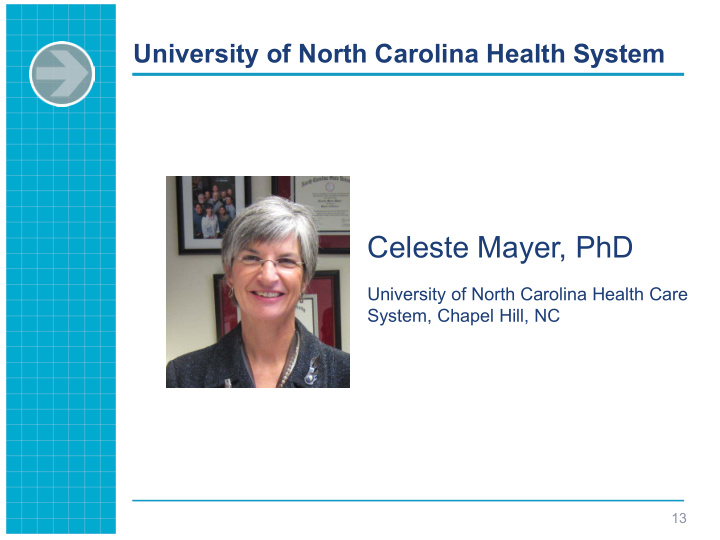



University of North Carolina Health System Celeste Mayer, PhD University of North Carolina Health Care System, Chapel Hill, NC 13
UNC Medical Center • Public Academic Medical Center • Memorial, Children’s, Neurosciences, Women’s and Cancer Hospital • ~850 beds • Chapel Hill, NC
My Role • Patient Safety Officer since 2003 • At UNC since 1988 • Reporting structure – VP for Quality – 2003 - 2007 – Chief of Staff – 2007 - 2014 – General Counsel – 2014 - present
Non-punitive Response to Error Survey Results over Time Survey UNC Medical Database Administration Center Teaching Period Average % Hospitals Positive Average % Positive 2006 July 36% 41% (2007) 2008 June 39% 42% (2009) 2009 December 46% 42% (2011) 2011 October 48% 41% (2012) 2013 December 51% 42% (2014) 2015 October 53% 43% (2016)
North Carolina Just Culture Collaborative 2006/2007 • What it was – Partnership between the NC Quality Center and Outcome Engineering • How I got involved – saw the opportunity • Proposed the idea for participation to the Chief of Staff • 10 NC Hospitals participated in a year-long learning and sharing experience - July 2006 to April 2007
How I pitched this to my boss • Inexpensive consulting • We were measuring • Foundational, next step work
Fortuitous Serendipity
The UNC Collaborative Team • Patient Safety Officer • Director for Risk Management • Attorney from the Legal Department • Director for Employee Relations • Human Resources Associate • Director for Nursing Education • Two Nurse Managers • Pediatrician • Anesthesiologist
The Collaborative • Prework – RCA Event documentation – Employee Corrective Action Reports – Patient Safety Activity Documentation – Policies; Corrective Action, Sentinel Events, Adverse Event Reporting – Patient Safety Plan – Code of Conduct, Employee Handbook, Medical Staff Bylaws • In-Person Learning/Sharing – 3 Days • Monthly conference calls
Creating Change • Acknowledge the shift • Many formal communications • Used visible support from high-profile leaders and organizations • Education • Weaving into the fabric of the organization • Policy Change
Practice into Policy Two years to change the Corrective Action Policy
Policy into Practice • Clear expectation for use of the Just Culture Algorithm • Mandatory training for new managers • Visibility to all staff • Requirements for documentation • Employee Relations involvement
Training • Manager and all comer training near the end of the collaborative (Feb/March 2007) • David Marx lead training for leadership and managers (May 2007) – Serendipity again – Organizational “Commitment to Caring” kickoff and folding Just Culture into the strategic plan – Offered Continuing Nurse Education credit for managers – Created a “cascade learning” document for managers to guide the sharing with staff • And since then Employee Relations leads training for all new managers – 1 hour concepts – Application practice using a case • Frontline staff experience Just Culture
Visibility to Staff • The algorithm – can be found displayed in most managers’ offices
The Algorithm
Requirements for Documentation 28
Sustainment Today • Regular measurement and Focus • Added 5 additional questions in 2015 1. My supervisor emphasizes learning rather than blame when staff make mistakes. 2. When staff take shortcuts that put patient safety at risk, supervisors or managers work with them to change their behavior. 3. Staff who see other staff doing something unsafe for patient care tell them it is unsafe. 4. Regardless of a person's job position, management applies the same disciplinary policy to everyone working in this hospital, including physicians. 5. When a patient safety event happens, hospital management looks at more than staff actions to determine what led to the event.
What Was and Is Most Important • Supportive and influential leader • The perfect learning collaborative opportunity • Incorporating Just Culture Principles into the Corrective Action policy • Incorporating Just Culture Principles into Counseling/Corrective action documentation • Regular measurement and sharing
Recommend
More recommend